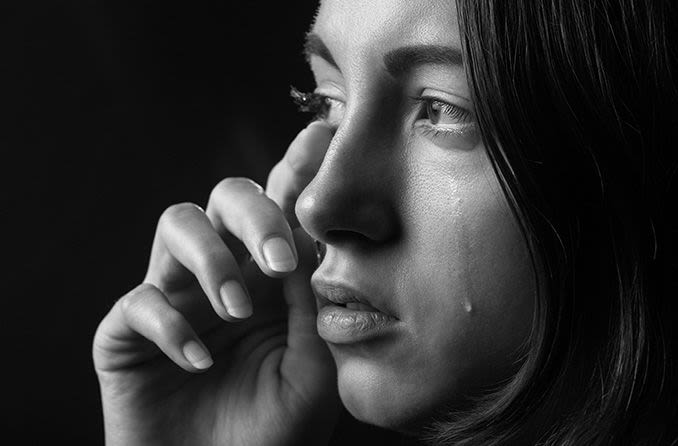Can I cry while wearing my contact lenses?

Whether it’s a bad breakup, an onion you’re chopping for dinner or a tearjerker of a movie, it’s likely that something will trigger tears while you’re wearing your contacts.
Tears are essential for keeping your eyes moist and allowing you to wear your contact lenses comfortably every day. But extra tears caused by certain situations can leave deposits on your lenses that blur your vision.
Crying also can cause eye irritation, which can be made worse by contacts.
There are three types of tears:
Basal tears lubricate and protect your eyes from dirt, dust and debris at all times.
Reflex tears wash away irritants such as onion fumes or smoke.
Emotional tears flow in response to joy, sadness and other feelings.
While there are always basal tears in your eyes, both reflex tears and emotional tears are released in larger quantities that can affect your contact lenses.
RUNNING OUT OF CONTACTS? Find an optical store near you or shop online.
What happens when you cry with your contacts in, step by step
Step 1: Tears are produced in the tear glands, or lacrimal glands, located just above each eyeball. These glands aren’t affected by your contact lenses, which sit on the surface of your cornea.
Step 2: The tears wash down over your eyes and get distributed across your eyeballs (and your contact lenses) as you blink. The extra moisture can affect the surface tension of your eyes and cause your lenses to move around slightly more than they would if your eyes were dry.
Step 3: The tears drain into puncta (tiny holes in the corners of your eyelids), go through a drainage system and flow down the back of your nose and throat. If your eyes produce a lot of tears, they may spill down your face.
Will crying make your contacts blurry?
Crying can affect your vision, at least temporarily. The enzymes, lipids and mucus found in tears can leave deposits that stick to your contact lenses and make your vision blurry.
Will crying make your contacts fall out?
Tears will lubricate your contact lenses and allow them to move a little more freely on the surface of the cornea, but should not cause them to pop (or fall) out of your eyes.
Is it bad to cry with contacts in your eyes?
It’s safe to cry with your contacts in as long as you avoid touching your eyes.
Rubbing or wiping one of your eyes could wrinkle or fold your contact lens, dislodge it from the cornea and cause it to get stuck under the upper eyelid.
If you rub, swipe or blot at your eyes with tissues, you could also rip or tear a soft contact lens. Even a tiny rip or tear in a contact lens can cause eye pain, irritation and more tears.
SEE RELATED: How to remove a contact lens that's stuck in your eye
Can you wear contacts after crying?
You can wear contacts after shedding a few tears as long as your eyes don’t feel irritated. However, you should take out your contacts any time your eyes are red and puffy.
So, you may want to clean and disinfect your contacts, and give your eyes a break, after a major crying jag.
How to clean contacts after crying
It’s smart to clean your contacts after you cry with your lenses in your eyes. You want to remove the deposits on the lenses along with any makeup that may have washed into your eyes while you cried.
Whether you wear soft contact lenses or rigid gas permeable contact lenses or hybrid lenses, here’s how to clean your contacts after crying:
Step 1: Wash your hands thoroughly with regular soap and water. Dry them with a clean, lint-free cloth.
Step 2: Take out one contact lens and clean it with the cleaning solution recommended by your eye doctor. Even if you use a “no rub” solution, you should still gently rub the cleaning solution onto the lens.
Step 3: Rinse the lens once, then gently rub and rinse it a second time.
Step 4: Place the lens in a clean case and cover with the disinfection solution recommended by your eye doctor.
Step 5: Complete the same process with your other contact lens and leave both lenses in the solution for the time required to complete the disinfection process.
Crying with contact lenses in is fine, and it likely will happen to almost every contact lens wearer sooner or later.
And if your vision gets blurry or your eyes get red and puffy, clean and disinfect your contacts and give your eyes a rest. Just make sure to avoid rubbing your eyes.
WHEN WAS YOUR LAST EYE EXAM? Find an eye doctor near you and schedule an appointment.
Page published on Friday, January 3, 2020




